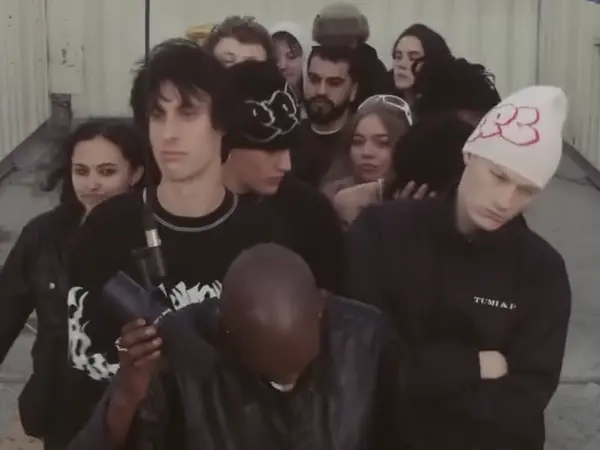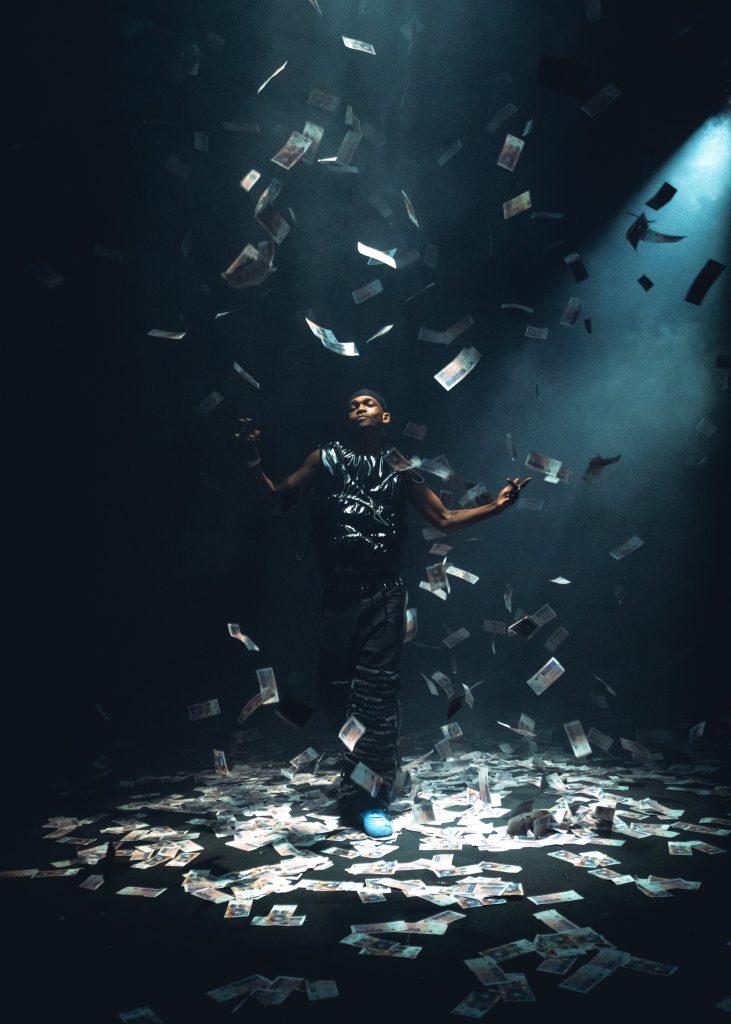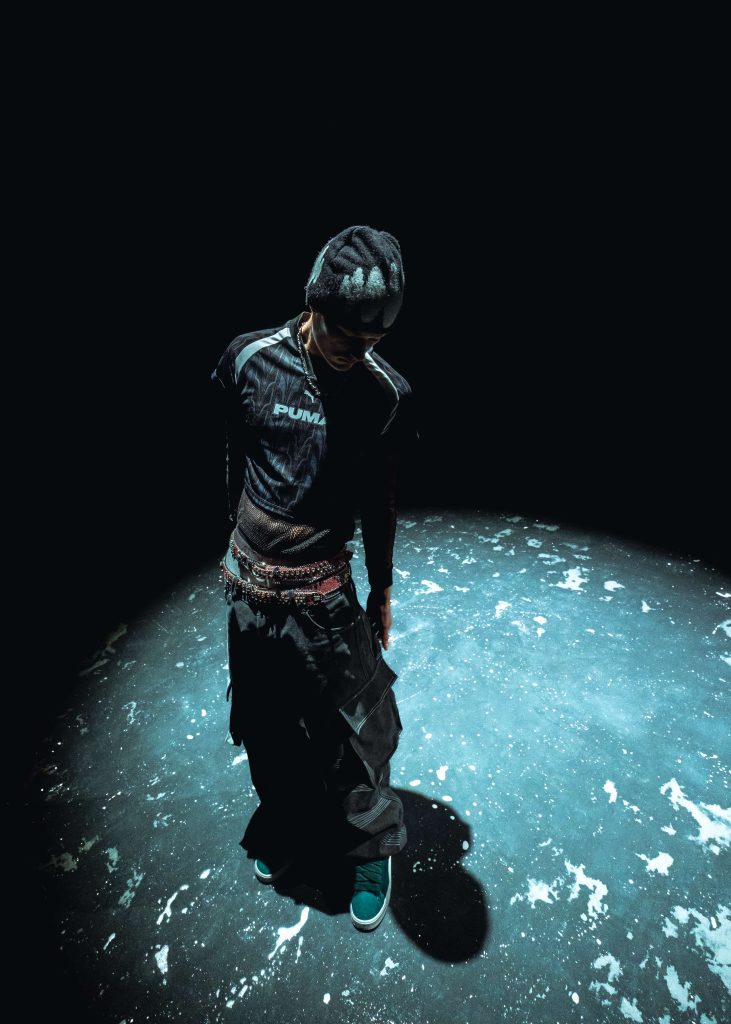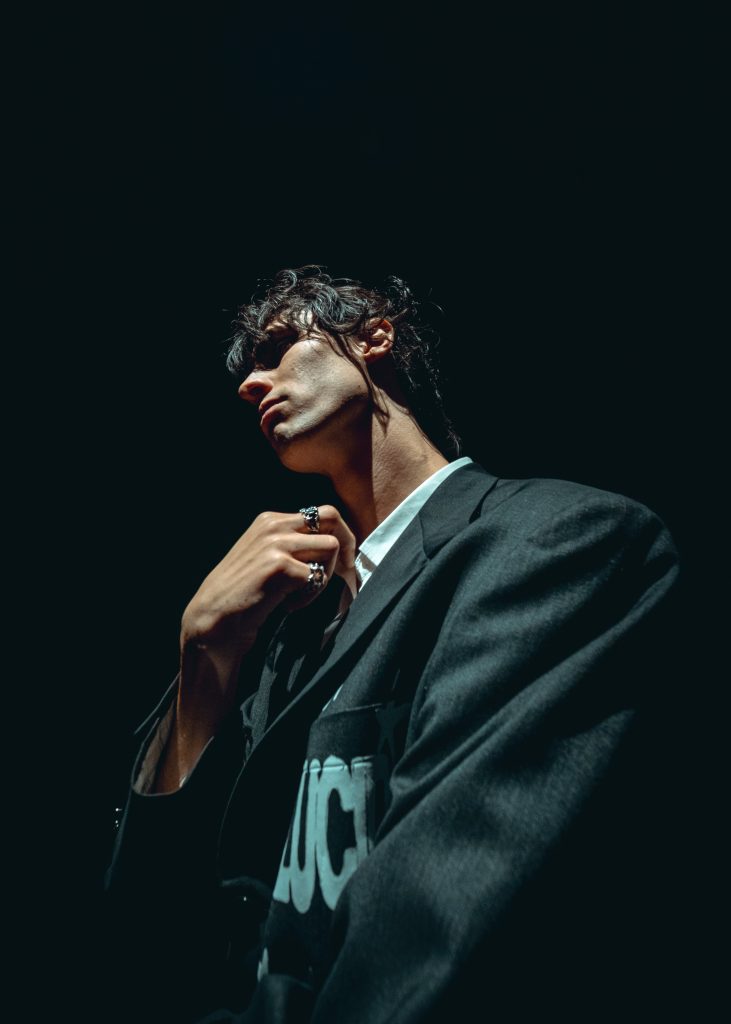
Meet Internet Girl, The South African Band Breaking All The Rules
Ahead of the release of the video for “PULL UP” The NATIVE speaks to the trio about their career and the process of putting ‘ROLE MODEL’ together.
Written by Wale Oloworekende – 3.Oct.2024
For the better part of the last decade, popular music from South Africa has undergone a seismic transformation. Amapiano, the generational, almost spiritual variant of Dance music that was born in the country’s townships, has gone on to dominate dancefloors both at home and abroad. Crowning stars such as DJ Maphorisa, DBN Gogo and Uncle Waffles, Amapiano’s dominance has led to a marginalisation of other genres in the mainstream conversation, with radio and show promoters casting aside acts that don’t incorporate the now inescapable log drum.
Just over a decade ago, a similar shift was occurring in Nigeria. As Afro-Pop rose to prominence, led by stars like Davido, Wizkid and Tiwa Savage, any artists not conforming to the sound of the day were alienated by the gate-keepers and industry tastemakers. What happened next was a cultural phenomenon known as the Alte movement, with artists and the communities that surrounded them – directors, producers, stylists – bucking against the machine, and making the music they felt like making. This movement propelled the likes of Burna Boy, Tems, Odunsi The Engine, Cruel Santino and more, as they started speaking directly to their fans, realising there was indeed a space for alternative music in West Africa.
Enter: Internet Girl, the three-piece South African band attempting to do the same, by breaking all the rules. Fusing Punk-Rock with Alternative Pop and an undeniable Hip-hop influence, the trio possess a distinct sensibility to deliver music and visuals that at once feel fresh and alternative; but somehow viscerally familiar. But it’s been a long road to this point. “It was very hard initially,” Matthew “Neese” Burgess, Internet Girl’s drummer and producer tells me via Zoom. “We were not focused on South Africa because we were like, ‘We don’t care about the African territory, we’ll just make music for the US because no one is going to fuck with us on this side.’ [So] we were doing that for a while, we weren’t playing shows or getting booked for shows but we were streaming well. Since last year, we’ve had a rethink and now know that we can manoeuvre these things so people in South Africa and Africa can fuck with us in terms of the swag that we bring and our image online. If you bring a sense of Hip-hop into your brand, people will like it even if you’re making guitar music. That’s what we’ve done and it’s easier to get booked for shows. We know where we fit in the scene a little better. We do care about our local territories and we appreciate everyone that fucks with us.”
The band is made up of Burgess, lead vocalist Ntstika “TK” Bungane, and guitarist/producer Griggs, who Bungane and Burgess met in 2019 after they found videos of him playing their songs online. As Internet Girl, the trio has released a wide range of projects exploring everything from the dark hole of melancholia to the zonked out escapism of indulging in narcotics. And after years of living in separate cities and figuring out their process, their 2024 project, ‘ROLE MODEL,’ finally saw them deliver a body of work that bears all the hallmarks of the grandeur and candour that Internet Girl aims for. A deluxe version of ‘ROLE MODEL’ houses “PULL UP (WHERE THE MUD BE),” their biggest song yet, that came about after Burgess flipped a melody he’d heard in a TikTok ad.
Alongside an exclusive premiere of the Royd-directed video for “PULL UP (WHERE THE MUD BE),” The NATIVE spoke to the trio about their career and the process of putting ‘ROLE MODEL’ together.

TK
Where did the name of the band come from?
TK: At a point, Matt and I were in a previous group and we just needed to change the name and everything. We were sitting somewhere and he was like, “Something like an e-girl or an internet girl,” and we just went with it.
Griggs: That’s the least interesting thing about the band because it doesn’t mean anything. It’s just a cool name. There’s no meaning behind it.
How did you all meet?
Neese: TK and I met in primary school. We’ve been homies since grade five. We were 10-year-olds so that’s about 15 years now. We’ve been homies for most of our lives and we were making music in high school. We met James over Instagram in 2019: he posted guitar videos of him playing our music and we liked it. He flew down from Cape Town to Jo’burg because TK and I were living in Jo’burg at the time. We just got to know each other and made music together. It worked out and he joined the band.
How has the dynamic been moving from being a duo to being a trio?
TK: It’s not been a big shift because with James, from the moment I met him, it felt like I’ve known him for a while. He has a cool temperament and likes the same music as us so it was quite easy to form a group and add him. With regards to responsibilities, they’re both producers and [they’ve taken] that role with the production we’ve had in the past. Now, we’ve all developed our skills differently and started taking on different responsibilities and roles.
Neese: We all have our different roles but it’s kind of naturally just evolved based on our different skills and what we’re good at. Everyone contributes to different things but it works out well and we’re all happy with the dynamic we have now.
The music you make has evolved from a heavy Trap influence to more Indie-Pop and Punk. What motivated that evolution?
Neese: I think we’ve learned to combine genres because we’ve been fans of different genres at different points in our lives. TK and I used to make a lot of Hip-hop and Trap stuff then we used to make a lot of Indie-Pop stuff because that’s the music we were listening to at that point. I used to listen to a lot of Electronic music back in the day and that’s how I started making music. As time has gone by, we’ve figured out a good way to combine all these things and it’s created a unique sound.
Griggs: If I have to think back to when we started the band, what we all brought in was very different and, after five years, we’ve all become so much better at different things. We are all capable of doing everything because you’re spending your time with everyone and your general music-making ability is all-encompassing rather than just doing one thing. For example, when we’re in the room together, everyone contributes to every piece and it’s fun.
TK: With regards to the different genres, it’s always a reflection of what we’re listening to at the time. Our tastes change and that comes out in the music.
What was the process of making ‘Parasocial Interaction?’
Neese: ‘Parasocial Interaction’ is the EP before ‘ROLE MODEL.’ That EP is kind of a collection of singles similar to ‘The World I Love’ before it. We didn’t sit down and say, “We’d make an EP that sounds this way.” We were at a weird point in our career where we were living in different cities and weren’t spending a lot of time in the studio together. It was a true parasocial interaction. That whole project happened over the internet because we weren’t playing shows or doing anything. We were sending each other stems back and forth to do the songs and, I think, that was the inspiration behind it but I wouldn’t say the music is very thematic in that sense.
Griggs: I think ‘ROLE MODEL’ is our first piece of music that’s so cohesive because, after this much time in a band, we finally felt like it was the best representation of a conceptualised project representing what Internet Girl is about.

Neese
How did you approach making ‘ROLE MODEL’ ?
TK: ‘ROLE MODEL’ started towards the end of our ‘Parasocial Interaction’ era. We call it the Internet Girl flop era because we weren’t doing much together and we decided to make sure the next project was done properly. We left too many loose [ends] and weren’t intricate on ‘Parasocial Interaction.’ We wanted to go in on ‘ROLE MODEL’ and I think we did a good job.
What was the best thing about working on ‘ROLE MODEL’ together?
Neese: I think the best part was the experience of making it. We learned how to work in studios together properly whereas a lot of our music before then was done individually even when we lived together. I would work on music in my room, James would work on music in his room and TK would write in his room. Then we’d come together later to put it all together but, with this one, we just learned how to sit in a room together and make it all work.
Griggs: I had a lot of fun working on the project. It was one of the most fun times I’ve had because I was just spending time with the boys and working on music. We’re all like best friends and making music is just what we do together.
TK: I think with the previous projects there was a little bit of doubt in terms of what sounds to do. With this one, we were sure it was the right direction to go in and we just did it. I was also a little bit more involved in the production process and just contributed more to how everything sounded.
TK said that he got involved with production a lot more on ‘ROLE MODEL.’ What was the approach to making the songs, was it instrumental first and then writing or was it the reverse?
TK: The first song I did was the song, “ROLE MODEL.” I had just returned from work and I was pissed off so I needed to get it out. I didn’t have the boys with me but I needed to make the song so I had to work on it. I got home and started working on the guitar and playing around with the drum loop on FL. I made the most terrible drum sounds just to get the rhythm and I put it all together. The next day, I was pissed again so I wrote on it and sent it to the boys. So for me, the idea often came first before the actual production took place.
Griggs: It was half-half. “EVERY MAN FOR HIMSELF,” “ROLE MODEL,” and “COKEHEAD” started as rough guitar ideas and vocals that were then produced but instrumentals were premade for the rest of the songs on the project before TK wrote on them. I think it’s also fun to have these different approaches to it because it shows we can come together and make music in many ways.
TK: I think you can also hear the difference between those tracks even though they are on the same tape, they kind of exist in two different sections.
You also live in South Africa, which is having a huge global moment with Amapiano right now. How have you navigated making music that falls outside of that?
Neese: It was very hard initially. We were not focused on South Africa because we were like, “We don’t care about the African territory, we’ll just make music for the US because no one is going to fuck with us on this side.” [So] we were doing that for a while, we weren’t playing shows or getting booked for shows but we were streaming well. Since last year, we’ve had a rethink and now know that we can manoeuvre these things so people in South Africa and Africa can fuck with us in terms of the swag that we bring and our image online. If you bring a sense of Hip-hop into your brand, people will like it even if you’re making guitar music. If you have a Hip-hop swag, dress well, are cool online and have that influence in your music as well, people will like it. That’s what we’ve done and it’s easier to get booked for shows. We know where we fit in the scene a little better. We do care about our local territories and we appreciate everyone that fucks with us.
Griggs: There are aspects of what we do that are novel but there are also parts of what we do that are familiar to people and it makes it palatable to them. There’s something about it that’s not only not been seen but also not heard before. We also want to show the world that alternative music can come out of South Africa and the greater African region that’s not Amapiano or Dance music.
TK: People didn’t know what to expect or what to do. They used to be like, “Who are these people, two white dudes and a Black guy?” Now it’s cool. When we go to shows now, people know the lyrics and show love. Getting that love is very satisfying.

Giggs
How was “PULL UP (WHERE THE MUD BE)” conceived?
TK: “PULL UP” started with Matt. Matt saw a TikTok for an ad by a brand that had a melody. He made a flip of the melody and posted it on TikTok. He didn’t tell anyone but it started blowing up more than any of our other TikToks. People loved the beat. I was already writing some songs with the guitar to finish off ‘Role Model.’ I had just broken up with my girlfriend and I had stuff to say. I pulled up to Matt’s crib to write and he told me that he needed me to write to the instrumental of “PULL UP.” I wrote to it and he was like, “It is fire, we need to drop it.” Even the label wasn’t too sure because it’d fuck up their release plan but Matt insisted that we needed to drop it. We posted a new version of the song with vocals on and that started blowing up too. We did a TikTok saying we’d drop the song if we got 10,000 comments and people started getting pissed and asking why we were gatekeeping the song. I had no idea it would go crazy like it has but it ended up changing our lives.
Do you think that experience has changed your approach to making music?
TK: It has given us more confidence in terms of going into the studio and knowing that people fuck with our music. I feel like the perception has changed and people think we’re dope so they’re more open to accepting what we’re putting out which just gives you more confidence.
Neese: Also, I think it’s helped us understand that you can’t be too rigid with your release schedule. You can have a schedule for sure but you need to be flexible otherwise you’ll shoot yourself in the foot.
Griggs: There was no spend. We had spent all our budget on the ‘ROLE MODEL’ project so all the promo on TikTok and creating the cover art was done in-house by us but it has done better than every song that we put time into and that speaks to the power of social media and branding stuff well.
Finally, the video for “PULL UP (WHERE THE MUD BE)” is here. What was the idea for the video?
Neese: We worked with our homie, Royd, on that video. He’s done all our video stuff and we just gave it to him. He was like, “I want to do a black and white video and I want it to be super shiny because the song just has a black and white feeling.” We just trusted him and showed up on the day. Usually, we’re very involved in the process but we just decided to trust him because we were very busy. We pulled up on the day and it was so sick. Maglera Doe Boy was there and it was dope. We’d met Maglera before but it was cool to see him in that environment and watch him perform for the camera.
Griggs: Royd has known Matt and TK for ages so it’s like we’ve built this world visually and sonically with a core group that understands our vision. There are not too many chefs in the kitchen. He’s our guy and we’ve worked with him for so long that he understands us and can pull off something crazy. The video turned out great and we’re so stoked.
